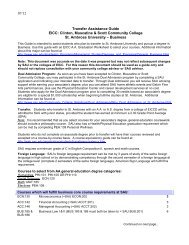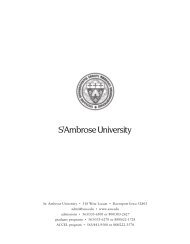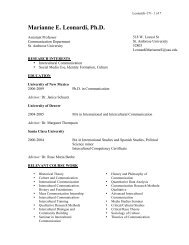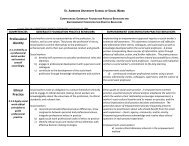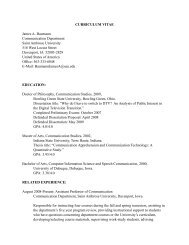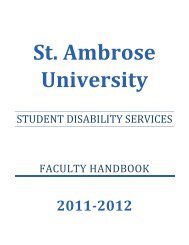St. Ambrose Legends Retire - St. Ambrose University
St. Ambrose Legends Retire - St. Ambrose University
St. Ambrose Legends Retire - St. Ambrose University
Create successful ePaper yourself
Turn your PDF publications into a flip-book with our unique Google optimized e-Paper software.
Jeremy Koch ’02 is the project director for the USAID-funded Teach<br />
English for Life Learning (TELL) Program in Ethiopia. He and his wife,<br />
Kimberly, have lived in Africa for more than four years. Koch agreed<br />
to share his observations about the ongoing drought and famine on the<br />
Horn of Africa with fellow Ambrosians.<br />
Jason ’00 MPT and Andrea (Moss)<br />
Elgin ’00 MPT welcomed a baby<br />
boy, Eli, to their family on Dec. 29,<br />
2011. Eli is little brother to Kaitlyn,<br />
Jadyn, and Alexis.<br />
Elizabeth (Boardman)<br />
Hulsbrink ’00 and her husband<br />
Jeff celebrated the birth of their<br />
daughter, Elouise, on Oct. 5, 2011.<br />
Elouise was welcomed home by her<br />
big sister Clare.<br />
Eric ’01 and Amy (Bialon) Jensen<br />
’01 are happy to announce the birth<br />
of their son, Luke Thomas, born on<br />
July 6, 2011.<br />
Adam ’02, ’04 MOL and Mimi<br />
(Krupke) Clark ’04, are happy to<br />
announce a new addition to their<br />
family, Caden Kwan, on Mar. 10,<br />
2011.<br />
Joe ’03 and his wife Trina (Gillen)<br />
Murray ’04 celebrated the birth of<br />
twin daughters, Rowan Kimberly<br />
and Brynn Taylor on July 3, 2011.<br />
Allison (Hemphill) <strong>St</strong>anley ’03,<br />
’04 MOT and her husband Scott<br />
are proud to announce the birth<br />
of their daughter, Alyssa, on July<br />
18, 2011.<br />
Kristy (Hand) Volesky ’03, ’06<br />
MOL and her husband Matt,<br />
brought home a baby girl, Katelyn,<br />
born on June 29, 2011, who will be a<br />
little sister to sibling Brooklyn.<br />
Nicole (Blazina) ’04 and David<br />
“D.J.)”Brown ’05 celebrated the<br />
birth of a baby girl, Addison Marie,<br />
on Nov. 3, 2011.<br />
Lindsay (Crane) Vargas ’04 and<br />
her husband, Kevin, are the proud<br />
parents of a girl, Maggie, born Aug.<br />
27, 2011.<br />
Hope in the Horn of Africa<br />
The Horn of Africa is no stranger to drought<br />
and famine. There have been 42 droughts in<br />
the Horn since 1980. The 2011 famine was<br />
caused by the worst drought the region has<br />
seen in 60 years. It is a chronic challenge for<br />
the people and governments of the region, and<br />
many wonder if the Horn will ever be able to<br />
rid itself of famine.<br />
The World Food Program estimates that<br />
more than 13 million people have been affected<br />
by the ongoing famine and that number continues<br />
to rise.<br />
Amid the current emergency response, however,<br />
a story of hope has emerged, one starkly<br />
at odds with the too-memorable images of the<br />
drought and famine in Ethiopia in the 1980s.<br />
Efforts of the last 15 years to limit the devastation<br />
have borne fruit. That famine affected<br />
about 8 million Ethiopians; the current famine<br />
is affecting about half that many. Instead of<br />
creating refugees, Ethiopia is housing refugee<br />
camps to support those fleeing the famine in<br />
neighboring countries. Ethiopia is no longer<br />
the face of famine; instead it is a part of the<br />
response effort.<br />
With the support of international<br />
development organizations, Ethiopia has<br />
made significant investments to expand its<br />
water distribution infrastructure and make<br />
fertile land more productive. Health extension<br />
workers have been mobilized to provide much<br />
needed medical care. Cereal banks have been<br />
established to ensure that farmers can feed their<br />
livestock. There is still a lot of work to do, but<br />
the progress is undeniable.<br />
To an expatriate living and working in<br />
Addis Ababa, the capital of Ethiopia, the<br />
drought is hardly noticeable. This, too, is a<br />
sign of progress. The limited geography<br />
of the drought-affected areas helps focus<br />
the response effort.<br />
Continuing along this path of<br />
development means a day may come in<br />
the not too distant future when Ethiopia<br />
can say that it has brought an end to<br />
famine within its borders. This would<br />
be a tremendous achievement and could<br />
serve as a model of development for other<br />
countries suffering from chronic droughts<br />
in the Horn of Africa.<br />
— Jeremy Koch ’02<br />
31






